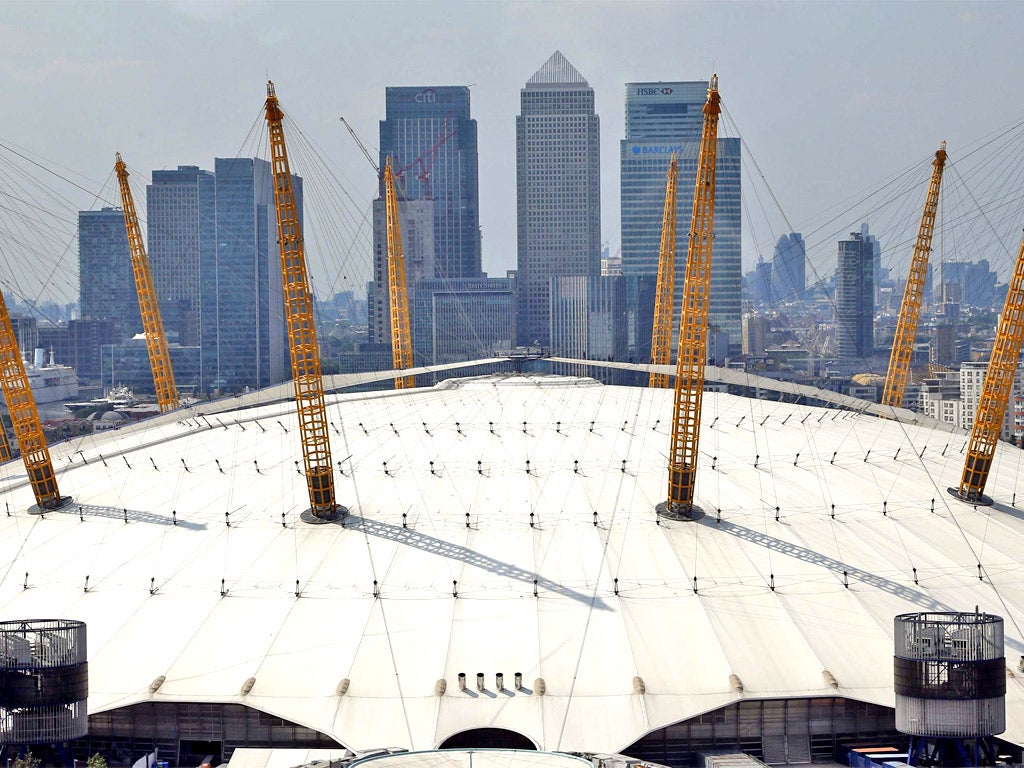Millennium Dome: The white elephant that learnt to fly
AEG, the group that turns sites in 'unloved areas' into prime concert venues, has picked the perfect time to sell the O2

It started life being dismissed as a New Labour vanity project, then disappointed thousands of visitors with its overly sponsored "zones". When it failed to entice the six million Britons who had been expected to go through its turnstiles, it was almost pushed into bankruptcy. Little surprise that the Millennium Dome was panned as an awfully big, ugly white elephant. When its tenancy of enormous models of bodies came to an end at the close of 2000, the Government desperately hawked it around for a sale.
But 12 years on, the reputation of Greenwich's Dome – or the O2 Arena, as it is now known, thanks to a £6m-a-year naming deal with Telefónica – has been transformed. So much so that when news emerged yesterday that the US billionaire Philip Anschutz, 72, was putting his Anschutz Entertainment Group – which owns the O2 and stakes in other sports, music and entertainment businesses – up for sale, experts said its assets could fetch as much as $7bn (£4bn), making it one of the biggest sports and entertainment deals on record.
Hiring the corporate advisory group Blackstone to work on the sale, Cannon Harvey, the president of AEG's holding firm, Anschutz Company, said it was "an appropriate time" to sell AEG.
That's certainly the case for its long lease of the O2. Just weeks ago the eyes of the world were on the site – rebranded, to spare the International Olympic Committee's sensibilities, as the North Greenwich Arena – as it hosted the gymnastics and basketball events at London 2012.
AEG's other assets include stakes in David Beckham's football team, LA Galaxy, and the Los Angeles Lakers basketball team, as well as concert venues in Berlin, New York, Shanghai and Sydney. As with the O2, it has focused on sites in unloved areas, believing fans will come to see stars such as Madonna or Justin Bieber wherever they're playing.
That has proved true in Los Angeles, where AEG helped to turn around the largely abandoned downtown area into an entertainment destination, with the 20,000-seat Staples Center at its core. Likewise, at the O2 arena. Now the most popular music venue in the world by ticket sales, it feels like a long time since the Dome was so bogged down in controversy that newspapers appeared to have changed its name to the "troubled Dome".
But although the building itself, designed by the Richard Rogers Partnership, cost about £43m to build, the total bill for the Dome project exceeded £600m.
Papers released by the National Archives a few years ago revealed that the Dome's original operating company struggled to pay its bills from the week the attraction opened its doors. ran out of money by 28 January 2000 – four weeks after its opening night. The Millennium Commission ended up having to make repeated trips with a begging bowl to the National Lottery's pot of cash.
And once the millennial exhibitions closed down there was still huge uncertainty about what to do next. In talk reminiscent of the legacy plans for the Olympic stadium, football clubs began investigating the possibility of using the structure. Charlton Athletic were considering turning it into a 45,000 all-seater stadium.
Ultimately the Government disposed of the Dome for a nominal sum – reportedly £1 – to Meridian Delta, a consortium led by Philip Anschutz, alongside Lend Lease, the Australian firm behind the Bluewater shopping centre in Kent, and Quintain Estates, which owns 14 acres of land on the site. The latter two sold their interest in the site's freehold when Trinity College Cambridge, bought the holding company of the 999-year lease for the Millennium Dome three years ago. But AEG took on the Dome.
Talk of turning it into a "super casino" didn't get past the drawing board, but the US group went on to invest more than £350m in the site, turning it into the 20,000-seater arena and shopping complex which sold nearly two million tickets last year.
It's not the first time that Mr Anschutz has considered punting off AEG. In 2008, events giant Ticketmaster and Cablevision were close to completing a deal to buy a 49 per cent stake in AEG Live, the firm's concert arm, for some $400m. But talks collapsed and Ticketmaster went on to merge with Live Nation. But this time the selling intent seems serious.
It's five decades since Mr Anschutz, starting making the fortune that saw Forbes reckon his wealth at $7bn last year. He bought out his father's drilling company in 1961, but his first major deal was seven years later, when one of his Wyoming wells caught fire.
Instead of counting his losses, he charged Universal Pictures $100,000 to film the scenes for a movie the studio was making about fire fighter Red Adair. This time around, it's Anschutz' deal that is set to be the blockbuster.
Millennium Dome: A timeline
1994 John Major's Tory government first raises the idea of building an enormous dome to mark the start of the new millennium.
1995 A committee of MPs approves the plans.
1997 Approached by the Tories, new Prime Minister Tony Blair at first refuses to give his approval to the project, then relents.
1998 Dome officials admit that its net grant requirement was £441m rather than the original £399m. More than £150m extra Lottery cash is later allocated.
2000 Officials admitted visitor targets would be missed and breaking even "could not be guaranteed".
2001 Announcement of the sale of site to the Meridian Delta consortium led by Philip Anschutz.
2009 Trinity College Cambridge spends £24m buying the holding company of the 999-year lease for the Millennium Dome.
Join our commenting forum
Join thought-provoking conversations, follow other Independent readers and see their replies
Comments
Bookmark popover
Removed from bookmarks